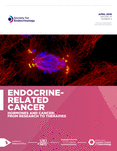Current and emerging biomarkers in breast cancer: prognosis and prediction
- 1The Institute of Cancer Research, Breakthrough Breast Cancer Research Centre, 237 Fulham Road, London SW3 6JB, UK
2Royal Marsden Hospital, Fulham Road, London SW3 6JJ, UK
- (Correspondence should be addressed to M Dowsett; Email: mitch.dowsett{at}icr.ac.uk)
Abstract
Breast cancer treatment has experienced several changes in the past decades due to the discovery of specific prognostic and predictive biomarkers that enable the application of more individualized therapies to different molecular subgroups. These subgroups show specific differences regarding biological clinical behavior. In addition to the classical clinical prognostic factors of breast cancer, established molecular biomarkers such as estrogen receptor and progesterone receptor have played a significant role in the selection of patients benefiting from endocrine therapy for many years. More recently, the human epidermal growth factor receptor 2 (HER2) has been validated to be not only a prognostic factor, but also a predictor of response to HER2 targeting therapy. The shift toward an earlier diagnosis of breast cancer due to improved imaging methods and screening programs highlights the need for new factors and combinations of biomarkers to quantify the residual risk of patients and to indicate the potential value of additional treatment strategies. The marker of proliferation Ki67 has recently emerged as an important marker due to several applications in neoadjuvant therapy in addition to its moderate prognostic value. With the introduction of high-throughput technologies, numerous multigene signatures have been identified that aim to outperform traditional markers: current prospective clinical trials are seeking evidence for their definitive role in breast cancer. There exist many more factors and approaches that have the potential to become relevant in the near future including the detection of single disseminating and circulating tumor cells in blood and bone marrow as well as of circulating cell-free DNA and microRNA. Careful randomized prospective testing and comparison with existing established factors will be required to select those emerging markers that offer substantial cost-effective benefit and thereby justify their routine use for breast cancer therapy decision-making.
- © 2010 Society for Endocrinology












